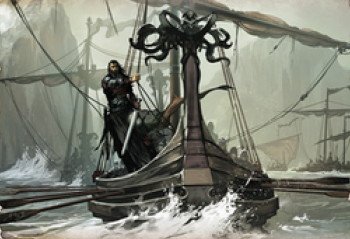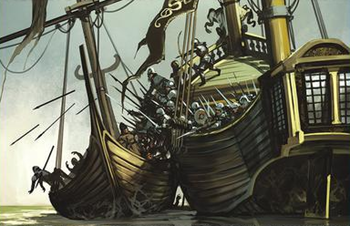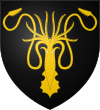Iron Islands

The Iron Islands,[1] the Iron Isles,[2] or the Kingdom of the Iron Isles,[3] is one of the constituent regions of the Seven Kingdoms. The isles were historically ruled by rock, salt, and High Kings chosen in kingsmoots, next by hereditary Kings of the Iron Islands, and then briefly by Kings of the Isles and the Rivers. Since Aegon's Conquest, the region has been ruled by House Greyjoy, Lords of the Iron Islands, from their castle of Pyke.
The Iron Islands are home to a fierce seafaring people who call themselves the ironborn. While some say the archipelago is named after the abundant iron ore on the islands, the ironmen claim it is instead named after their own unyielding nature.[4] It is often said that every captain is a king aboard his own ship, so the islands are also called "the land of ten thousand kings".[5]
Notable houses have included Blacktyde, Botley, Drumm, Goodbrother, Greyiron, Harlaw, Hoare, Merlyn, Stonehouse, Sunderly, Tawney, and Wynch.[6][7] Bastards of noble origin from the Iron Islands receive the surname Pyke.
Contents
Geography
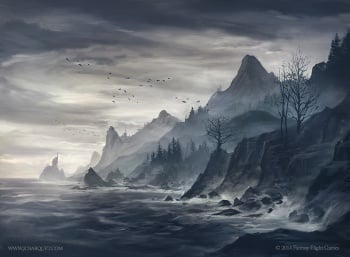
The Iron Islands is an archipelago in Ironman's Bay, located in the Sunset Sea off the western coast of Westeros. They are roughly west of the riverlands, northwest of the westerlands, and south of the north.
The main grouping of islands numbers thirty-one, with the seven major isles being Pyke, Great Wyk, Old Wyk, Harlaw, Saltcliffe, Blacktyde, and Orkmont. Eight days sail northwest of Great Wyk is a smaller grouping of thirteen clustered around the Lonely Light. Some of the Iron Islands are used for sheep grazing or are uninhabited.[4] The islands are ruled from the castle of Pyke, the seat of House Greyjoy on the island of the same name.
The Iron Islands is the smallest of the regions of the Seven Kingdoms. Dorne is the least populous of the Seven Kingdoms according to Doran Martell, but it is unclear if he is also including the Iron Islands in this estimate.[8]
The Iron Islands are small, barely-fertile rocks.[4] The grey, overcast weather has frequent rainfall,[9] and the seas around the isles are often stormy.[10]
People
The inhabitants of these harsh isles are known as ironmen,[5] especially by the rest of Westeros,[6] but they also call themselves the ironborn.[5] They are a seafaring people, and some do not like to be far from the sea.[11] The priests of the Drowned God likewise seldom stray far from the sea.[4] The ironborn are considered independent, fierce, and sometimes cruel. They live in a harsh land and hold no love for the peoples of the mainland Westeros, whom they consider green and weak.[5]
The Faith of the Seven and the old gods find small favor with the ironborn, as their allegiance is given to their native Drowned God. Because of the scarcity of the Faith, there are few knights in the islands; known knights include Ser Harras Harlaw and Ser Aladale Wynch. Some ironmen believe in returning to the Old Way of reaving and paying the iron price.[5][12][13]
Economy
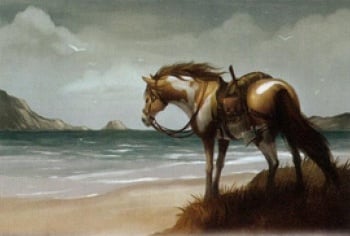
The islands are sparse and rocky with a thin, stony soil that makes it hard for the smallfolk to farm, and they often have to do without animals that might make their job easier, such as oxen or horses.[9] While their mines do not produce the precious metals of the westerlands,[5] iron is abundant on the isles.[4] Lead and tin can also be obtained. Most ironborn feel the dangerous and backbreaking labor required to mine these metals is work suitable only for thralls. With so little wealth on the islands themselves, it is not difficult to understand why the ironborn of old turned to raiding. Archmaester Haereg suggests that need for wood was what first drove the ironborn to raid the mainland.[4]
Ironman's Bay contains schools of cod, black cod, monkfish, skate, icefish, sardines, and mackarel, and the shores of the isles have crabs and lobsters. Seven out of every ten families are fisherfolk, according to Archmaester Haereg.[4]
Military strength
According to a semi-canon source from 2005, the Iron Isles can raise approximately twenty thousand men and five hundred longships.[14] The Iron Fleet alone consists of one hundred ships which are three times larger than the standard longship.[10] A longship such as Sea Bitch has fifty oars, while Great Kraken and Iron Victory are larger.[9] George R. R. Martin has indicated that the major lords of the ironborn can each float around a hundred ships.[15] The only fleets comparable to those of the Iron Islands are the royal fleet in the crownlands and the Redwyne fleet at the Arbor.[16]
History
Settlement
Maesters believe the Iron Islands were settled by the First Men many thousands of years ago. Legends claim that the First Men discovered what would be called the Seastone Chair upon the shores of Old Wyk.[9] There is no evidence the islands were inhabited by children of the forest or giants. Weirwood trees do not grow in their poor soils, so the old gods did not have significant followers there. Instead, the humans who came to inhabit the islands worship their own local religion of the Drowned God.[4]
Differing from maesters, the priests of the isles claim the ironmen are not First Men in origin but were created in the image of the Drowned God, and they therefore may have a connection with merlings. Some also suspect that the isles were originally inhabited by the Deep Ones, and that they are the ones who left the Seastone Chair behind.[4]
Most ironborn believe that their ancestors were an offshoot of the First Men who simply crossed to the isles on boats, where their culture developed differently from their mainland cousins.[4] The ancient First Men kept thralls, hinting that the ironborn were also First Men who retained the practice in their isolation.[4]
Kingsmoots
According to legend, the islands were ruled by the Grey King during the Age of Heroes.[17] For much of their history, each island was its own kingdom and had its own kings, a rock king who ruled the land and a salt king who commanded at sea. Chosen by kingsmoot, these petty kings constantly fought with each other, and they raided the First Men of mainland Westeros for timber, crops, and thralls.[17]
The islands were first unified when a powerful priest of the Drowned God, Galon Whitestaff, decreed it was sinful for ironborn to make war upon other ironborn. The other priests preached his word throughout the isles, until the various kings and longship captains convened on Old Wyk at Nagga's Bones for the first kingsmoot to select one High King of the Iron Islands to rule over all. Galon decreed the title was not hereditary, but upon the death of each High King a new kingsmoot would be convened to elect another. The new high kings were also called driftwood kings because of their crowns of driftwood.[4]
The kingsmoots on Old Wyk ended the petty wars between each of the isles, and with their new unified strength, the High Kings began to conquer other lands instead of just raiding them. Under the rule of King Qhored the Cruel, the ironborn brought much of the western coast of Westeros under the rule of the Iron Island, including lands as far as Bear Island, the Arbor, and Oldtown.[6] They were gradually lost by his successors, however, as mainland houses such as the Hightowers, Gardeners, and Lannisters increased in strength. The High Kings came from numerous houses, with most coming from Houses Greyjoy, Goodbrother, and especially Greyiron.[17][7]
The Greyiron dynasty
Upon the death of High King Urragon III Greyiron, his younger sons convened a kingsmoot which chose Urrathon IV Goodbrother, although Urragon's elder son, Torgon Greyiron, was away raiding the Reach. Supported by priests unhappy with Urrathon's tyranny, Torgon declared the kingsmoot invalid when he returned to the Iron Islands, and the so-called Badbrother was overthrown. Although Torgon the Latecomer was wise, the ironborn were still in decline and the Cape of Eagles was lost to the Mallisters of Seagard. Torgon had his son rule alongside him for several years, and Urragon IV Greyiron thus also became High King without being chosen in a kingsmoot.[17]
The dying wish of Urragon IV was that the high kingship pass to his great-nephew Urron Greyiron, salt king of Orkmont. When the priests insisted that a kingsmoot be held at Old Wyk, Urron had his men slaughter those who attended, including thirteen other kings and half a hundred priests.[5] Urron Redhand established the hereditary rule of House Greyiron over the Iron Islands. Instead of being called High Kings, they titled themselves King of the Iron Islands and wore iron crowns. Abolishing the system of rock and salt kings, the Greyirons reduced other ironborn kings to vassal lords and extinguished families who refused to submit.[18]
While the driftwood kings were elected by consent of the lords and captains, the iron kings led to infighting among the ironborn, which the priests were unable to stop. The Greyirons faced half a dozen major rebellions, numerous smaller insurrections and insubordinations, and at least two major thrall uprisings.[18]
The stronger and larger kingdoms of the green lands took advantage of the ironborn's disunity to take back conquests on mainland Westeros. For instance, Garth VII Gardener, King of the Reach, drove the ironmen from the Shield Islands and fortified them to prevent ironborn raids up the Mander.[19][18]
Unlike the First Men, the Andals built strong ships capable of fighting ironborn longships. During the coming of the Andals, wooden stockades of the First Men with replaced with stone castles throughout the Reach, the riverlands, and the westerlands, new defenses against the lightning raids of the ironborn. All of their possessions lost, the Greyirons barely held on to power, and the isles increasingly divided into civil wars. After a thousand years of hereditary rule, the Greyirons fell to a coalition of ironborn lords and Andal adventurers, who often intermarried with the natives of the Iron Islands.[18]
The Hoare dynasty
The Greyirons were replaced as hereditary Kings of the Iron Islands by House Hoare, who intermarried with the Andals when they came to the isles. The priests of the Drowned God considered the Hoares ungodly and false kings, which Archmaester Hake agreed with. Archmaester Haereg, however, believed the Hoares were disliked for tolerating the Faith of the Seven, discouraging reaving, and promoting trade.[20]
The priests eventually rebelled against King Harmund the Handsome, led by a priest remembered as the Shrike. They overthrew Harmund within a fortnight and mutilated his mother, Dowager Queen Lelia Lannister, which led to a long war with the westerlands which left the Iron Islands impoverished and ill-prepared for the Famine Winter.[20] Ser Aubrey Crakehall claimed the islands for himself during the war, but he was swiftly overthrown by the ironmen.[20]
It took centuries for the Iron Islands to recover, during which ironmen began to trade with coastal Westeros and the Free Cities. Only a shadow of what they once were, the ironborn no longer held territories on the fortified mainland and instead reaved in distant places, such as the Basilisk Isles, Stepstones, and Disputed Lands.[20]
Kings of the Isles and the Rivers
A few generations before the Wars of Conquest, the peaceful King Qhorwyn the Cunning built a strong fleet to deter attack.[20] His ambitious son, King Harwyn Hardhand, then conquered the Trident on the mainland from the Storm King Arrec Durrandon.[6] Instead of relinquishing control of the territory to rivermen, the Hoares ruled both the riverlands and the Iron Islands as Kings of the Isles and the Rivers. Harwyn's son, King Halleck, ruled from Fairmarket on the Blue Fork of the Trident rather than from the Iron Islands, and he led unsuccessful campaigns against the stormlands, the westerlands, and the Vale of Arryn.[20]
Halleck's son, King Harren the Black, ordered the construction of Harrenhal, an enormous castle on the northern shore of the Gods Eye in central Westeros. The building of Harrenhal over forty years beggared both the Iron Islands and the riverlands.[21]
The Hoare line ended with the deaths of Harren and his sons during Aegon's Conquest. Inspired by Aegon Targaryen, Lord Edmyn Tully led the river lords in rebellion against the Hoares at Harrenhal.[22] Harren refused to yield to Aegon and the castle was too strong to storm, so Aegon flew his dragon, Balerion, over the walls and roasted Harren and his sons in their tower.[23] Most of Harren's supporters were killed in the burning of Harrenhal or by river lords as they retreated back to Ironman's Bay,[7] and Aegon granted rule over the riverlands to House Tully of Riverrun.[24]
The Greyjoys under the Iron Throne
In 2 AC, King Aegon I Targaryen led an invasion of the Iron Islands to defeat the various pretenders to Harren the Black's throne, including Qhorin Volmark and Lodos. Aegon then allowed the defeated ironborn to choose Lord Vickon Greyjoy of Pyke to rule as the new Lord of the Iron Islands, a vassal of House Targaryen which now ruled the Seven Kingdoms from the Iron Throne.[7] House Greyjoy relinquished all claims to the riverlands, and Aegon granted the ruins of Harrenhal to House Qoherys.[25]
Lord Vickon was a cautious ruler who did not provoke House Targaryen and its dragons, and he allowed the Faith of the Seven to return to the Iron Islands. His son, Lord Goren Greyjoy, suppressed a conspiracy to crown Qhorin Volmark and a revolt by a priest calling himself Lodos the Twice-Drowned, and in return King Aenys I Targaryen allowed Goren to expel the Faith from the archipelago for another century. After Goren, the weakened Iron Islands remained aloof from mainland politics for the next hundred years.[3]
Lord Dalton Greyjoy, the Red Kraken, raided the western shores during the Dance of the Dragons, capturing land from the westerlands. He was murdered at Faircastle in 133 AC by a salt wife, Tess, and a struggle for power broke out between his two infant salt sons, Toron and Rodrik, his sisters and good-brothers, his cousins, and the pretender Sam Salt.[26][27] In 134 AC, Lady Johanna Lannister allied with Ser Leo Costayne to invade the islands in reprisal and conquer them for her son, Lord Loreon Lannister, though Lord Toron remained on the Seastone Chair by the war's end.[7][27]
During the reign of King Aerys I Targaryen, Lord Dagon Greyjoy, the Last Reaver, led the ironborn in again raiding the western coast of Westeros.[28][29][3]
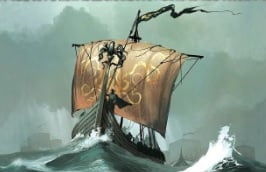
The Iron Islands supported the Iron Throne during the War of the Ninepenny Kings, with Lord Quellon Greyjoy leading a hundred longships to fight in the Stepstones.[3] Quellon outlawed thralldom and wanted to integrate the Iron Islands into the rest of the Seven Kingdoms, and he pursued neutrality during Robert's Rebellion. Encouraged by his sons, however, Quellon joined the rebels after Prince Rhaegar Targaryen's death at the Battle of the Trident. Quellon made a token display of support for House Baratheon against the Targaryens, but the Lord of the Iron Islands was killed in battle at the Mander.[3]
Quellon was succeeded by his eldest surviving son, Lord Balon Greyjoy, who rejected his father's works and wanted to return to the Old Way of paying the iron price. Balon spent five years building the Iron Fleet, believing that the usurper Robert I Baratheon's reign was weak. In 289 AC, Balon declared himself King of the Iron Islands in a bid for independence from the Iron Throne.[3] Greyjoy's Rebellion had some early victories, destroying the Lannister fleet at anchor and raiding the western coasts, but Balon had misjudged Robert's position. The mainland rallied their support for Robert, and the Iron Islands were invaded by the king, his brother Lord Stannis, Lord Eddard Stark, Lord Tywin Lannister, and Ser Barristan Selmy.[3] Balon lost his two eldest sons in the war, and though Robert pardoned the would-be king in return for bending the knee, Balon's surviving son, Theon, was sent to Winterfell to be the ward and hostage of Lord Stark.[1]
Recent Events
A Game of Thrones
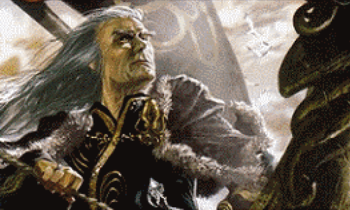
Lord Eddard Stark, now Hand of the King, advises Catelyn Stark to watch his ward, Theon Greyjoy. With tensions increasing in King's Landing, House Stark may need the Iron Fleet of Theon's father, Balon Greyjoy, Lord of the Iron Islands.[30]
A Clash of Kings
Warfare erupts in Westeros after the death of King Robert I Baratheon, Lord of the Seven Kingdoms. Seeking an alliance, Robb Stark, King in the North, sends Theon, his childhood friend, back to the Iron Islands as an envoy to Theon's father, Balon.[5]
Balon takes advantage of the instability and declares independence for the Iron Islands. Rather than ally with Robb against House Lannister and King Joffrey I Baratheon, Balon sends the ironborn to occupy key positions in the north and declares himself King of the Isles and the North.[31][32]
A Storm of Swords
Euron Greyjoy claims the Seastone Chair the day after Balon falls to his death at Pyke.[33] Sawane Botley, Lord of Lordsport, is drowned by Euron for stating that the throne belongs to Theon as Balon's son.[33][12]
A Feast for Crows

Aeron Greyjoy declares a kingsmoot on Old Wyk as the proper way to raise the next king after Balon's death.[12] This move is made by Aeron to end a potential civil war between the ironborn and to prevent Euron from taking the Seastone Chair. Victarion Greyjoy, Lord Captain of the Iron Fleet, returns from the Saltspear with most longships of the Iron Fleet.[34] However, Euron is chosen king despite the efforts of Aeron, Victarion, and Asha Greyjoy.[35]
Euron promises to conquer all of Westeros for the ironborn and expands their war by attacking the Shield Islands,[19] the Arbor,[36] and the Mander.[37] Euron offers to give the Seastone Chair and the Iron Islands to Victarion once the Iron Throne is claimed.[19] Baelor Blacktyde, Lord of Blacktyde, is killed for not accepting Euron as king.[19]
Euron sails from the Iron Islands to attack the Reach, beginning with the taking of the Shields.[19]
A Dance with Dragons
The castellan of Pyke, Erik Ironmaker, rules the Iron Islands in Euron's absence while he is on campaign.[38]
Victarion leads the Iron Fleet to Slaver's Bay on a mission to gain Daenerys Targaryen and her dragons for Euron's cause.[10] Victarion intends to claim Daenerys for himself, however.[13]
Houses
 House Blacktyde of Blacktyde
House Blacktyde of Blacktyde House Botley of Lordsport
House Botley of Lordsport House Codd
House Codd House Drumm of Old Wyk
House Drumm of Old Wyk House Farwynd of the Lonely Light
House Farwynd of the Lonely Light House Farwynd of Sealskin Point
House Farwynd of Sealskin Point House Goodbrother of Corpse Lake
House Goodbrother of Corpse Lake House Goodbrother of Crow Spike Keep
House Goodbrother of Crow Spike Keep House Goodbrother of Downdelving
House Goodbrother of Downdelving House Goodbrother of the Hammerhorn
House Goodbrother of the Hammerhorn House Goodbrother of Orkmont
House Goodbrother of Orkmont House Goodbrother of Shatterstone
House Goodbrother of Shatterstone House Greyiron of Orkmont
House Greyiron of Orkmont House Greyjoy of Pyke
House Greyjoy of Pyke House Harlaw of Grey Garden
House Harlaw of Grey Garden House Harlaw of Harlaw Hall
House Harlaw of Harlaw Hall House Harlaw of Harridan Hill
House Harlaw of Harridan Hill House Harlaw of the Ten Towers
House Harlaw of the Ten Towers House Harlaw of the Tower of Glimmering
House Harlaw of the Tower of Glimmering House Hoare of Orkmont
House Hoare of Orkmont House Humble
House Humble House Ironmaker
House Ironmaker House Kenning of Harlaw
House Kenning of Harlaw House Merlyn of Pebbleton
House Merlyn of Pebbleton House Netley
House Netley House Myre of Harlaw
House Myre of Harlaw House Orkwood of Orkmont
House Orkwood of Orkmont House Saltcliffe of Saltcliffe
House Saltcliffe of Saltcliffe House Sharp
House Sharp House Shepherd
House Shepherd House Sparr of Great Wyk
House Sparr of Great Wyk House Stonehouse of Old Wyk
House Stonehouse of Old Wyk House Stonetree of Harlaw
House Stonetree of Harlaw House Sunderly of Saltcliffe
House Sunderly of Saltcliffe House Tawney of Orkmont
House Tawney of Orkmont House Volmark of Volmark
House Volmark of Volmark House Weaver
House Weaver House Wynch of Iron Holt
House Wynch of Iron Holt
Quotes
Ironborn captains were proud and willful, and did not go in awe of a man's blood. The islands were too small for awe, and a longship smaller still. If every captain was a king aboard his own ship, as was often said, it was small wonder they named the islands the land of ten thousand kings.[5]
—thoughts of Theon Greyjoy
The islands are stern and stony places, scant of comfort and bleak of prospect. Death is never far here, and life is mean and meagre. Men spend their nights drinking ale and arguing over whose lot is worse, the fisherfolk who fight the sea or the farmers who scratch a crop from the poor thin soil. If truth be told, the miners have it worse than either, breaking their backs down in the dark, and for what? Iron, lead, tin, those are our treasures. Small wonder the ironmen of old turned to raiding.[5]
—Theon Greyjoy to the captain's daughter
The Iron Islands lived in the past; the present was too hard and bitter to be borne.[5]
—thoughts of Theon Greyjoy
The Old Way served the isles well when we were one small kingdom amongst many, but Aegon's Conquest put an end to that.[39]
References
- ↑ 1.0 1.1 A Game of Thrones, Chapter 4, Eddard I.
- ↑ A Feast for Crows, Chapter 32, Cersei VII.
- ↑ 3.0 3.1 3.2 3.3 3.4 3.5 3.6 The World of Ice & Fire, The Iron Islands: The Old Way and the New.
- ↑ 4.00 4.01 4.02 4.03 4.04 4.05 4.06 4.07 4.08 4.09 4.10 4.11 The World of Ice & Fire, The Iron Islands.
- ↑ 5.00 5.01 5.02 5.03 5.04 5.05 5.06 5.07 5.08 5.09 5.10 5.11 A Clash of Kings, Chapter 11, Theon I.
- ↑ 6.0 6.1 6.2 6.3 A Game of Thrones, Appendix.
- ↑ 7.0 7.1 7.2 7.3 7.4 The World of Ice & Fire, The Iron Islands: The Greyjoys of Pyke.
- ↑ A Feast for Crows, Chapter 40, Princess In The Tower.
- ↑ 9.0 9.1 9.2 9.3 A Clash of Kings, Chapter 24, Theon II.
- ↑ 10.0 10.1 10.2 A Dance with Dragons, Chapter 56, The Iron Suitor.
- ↑ A Dance with Dragons, Chapter 26, The Wayward Bride.
- ↑ 12.0 12.1 12.2 A Feast for Crows, Chapter 1, The Prophet.
- ↑ 13.0 13.1 A Dance with Dragons, Chapter 63, Victarion I.
- ↑ A Game of Thrones: d20-based Open Gaming RPG.
- ↑ So Spake Martin: Re: Greyjoy Fleet, February 9, 1999
- ↑ So Spake Martin: The Lannister Fleet, September 26, 1999
- ↑ 17.0 17.1 17.2 17.3 The World of Ice & Fire, The Iron Islands: Driftwood Crowns.
- ↑ 18.0 18.1 18.2 18.3 The World of Ice & Fire, The Iron Islands: The Iron Kings.
- ↑ 19.0 19.1 19.2 19.3 19.4 A Feast for Crows, Chapter 29, The Reaver.
- ↑ 20.0 20.1 20.2 20.3 20.4 20.5 The World of Ice & Fire, The Iron Islands: The Black Blood.
- ↑ A Clash of Kings, Chapter 7, Catelyn I.
- ↑ The World of Ice & Fire, The Reign of the Dragons: The Conquest.
- ↑ A Clash of Kings, Chapter 26, Arya VI.
- ↑ Fire & Blood, Aegon's Conquest.
- ↑ Fire & Blood, Reign of the Dragon - The Wars of King Aegon I.
- ↑ Fire & Blood, Under the Regents - The Voyage of Alyn Oakenfist.
- ↑ 27.0 27.1 Fire & Blood, The Lysene Spring and the End of Regency.
- ↑ The Sworn Sword.
- ↑ The Mystery Knight.
- ↑ A Game of Thrones, Chapter 20, Eddard IV.
- ↑ A Clash of Kings, Chapter 37, Theon III.
- ↑ A Clash of Kings, Chapter 49, Tyrion XI.
- ↑ 33.0 33.1 A Storm of Swords, Chapter 45, Catelyn V.
- ↑ A Feast for Crows, Chapter 18, The Iron Captain.
- ↑ A Feast for Crows, Chapter 19, The Drowned Man.
- ↑ A Feast for Crows, Chapter 45, Samwell V.
- ↑ A Feast for Crows, Chapter 36, Cersei VIII.
- ↑ A Dance with Dragons, Appendix.
- ↑ A Feast for Crows, Chapter 11, The Kraken's Daughter.
| ||||||||||||||
| ||||||||||||||||||||||||||||||||||||||||||||||||||||||||||
| |||||||||||
